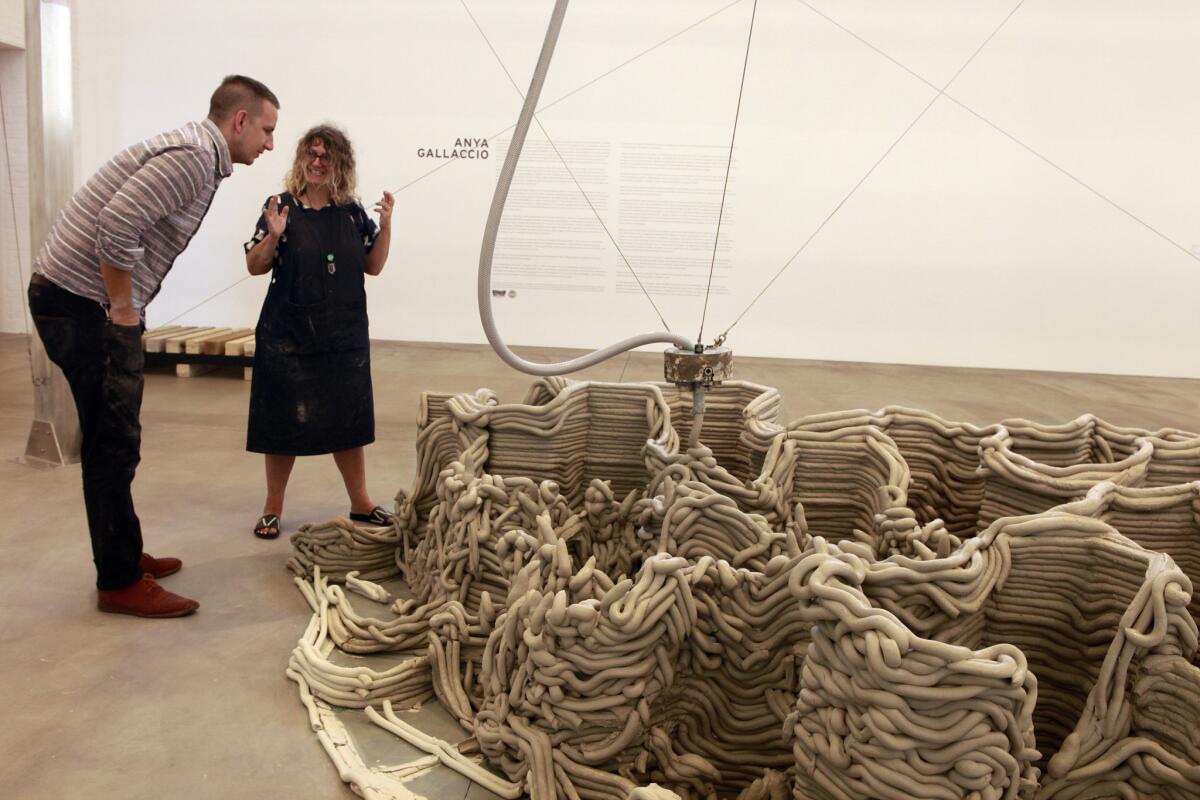Anya Gallaccio sets ‘beautiful minds’ in motion with 3-D clay printing in San Diego

Anya Gallaccio, local artist and professor from the University of California, San Diego, and Josh Miller, an assistant, discuss the clay formation from the Devil Tower creation July 23, 2015, at the Museum of Contemporary Art.
- Share via
Reporting from San Diego — British artist Anya Gallaccio covered a gallery floor with roses in Brussels, suspended apples in Amsterdam, worked with ice in London and painted walls with chocolate in Vienna and Los Angeles. In the course of each exhibition, the installations radically changed as her materials inevitably deteriorated.
At the Museum of Contemporary Art San Diego downtown she’s sculpting with clay. She’s creating a likeness of Devils Tower, a Wyoming monument that movie buffs may recognize from the 1977 science-fiction movie “Close Encounters of the Third Kind.” “It doesn’t look like Devils Tower, does it?,” said a bemused Gallaccio, surveying her handiwork.
Gallaccio moved from London to San Diego in 2008 to join the visual arts faculty at UC San Diego. She had collaborated with the MCASD and inSITE in the ‘90s, but she’s rarely exhibited locally since her arrival; she’s been busy over the last eight years with more than a dozen solo and group exhibitions in top U.S. and European galleries.
SIGN UP for the free Essential Arts & Culture newsletter >>
At MCASD, she has constructed and programmed an enormous 3-D clay printer, titled “beautiful minds,” to render the massive, geologically distinct national monument. Because of the nature of the material, which requires drying time, she’s having to print the sculpture incrementally. She’s spent an hour a day since the exhibition opened in mid-July building layer upon layer.
Though clay may not be as fragile as roses or chocolate, it does have a mind of its own. The computer is doing its best to lay down the clay in the precise grid dictated by the program Gallaccio and her students developed, but the clay is not cooperating. In some places it has collapsed in on itself and formed surprising shapes and patterns as the sculpture heads ever skyward, increasingly resembling some fantastical mountain.
“The idea, theoretically, is we’re supposed to get up to 9 feet,” Gallaccio said. “I don’t know if we’ll make it to 9 feet. Today might be the day it all falls over.”
Gallaccio has a practical explanation for why she often uses materials that wither, fade, rot, melt or collapse:
“For a lot of my work, it started quite pragmatically with the flowers and things,” said Gallaccio, who was born in Glasgow, Scotland, moved to London at age 5 and studied art at Goldsmiths College at the University of London. “I didn’t have a lot of money; I didn’t have a big studio where if you make paintings or sculptures you have to store them once you make them. Also, you make a lot of stuff to get better at making the stuff ... and you are just accumulating all this stuff.
“I thought I bypassed this very smartly by making things that went in the dumpster because then I didn’t have to find space to store them or take care of them or mend them when they got damaged. And I had some notion that it meant that the work was more of its time, that it was more in the present, more in the moment.”
That imperative was brought home when she first saw a painting by the Italian avant-garde artist Lucio Fontana, whose slashed canvases startled the art world in the mid-20th century.
“I don’t remember where it was, but it was slightly yellowing, it was 40 years old [and looked 40 years old], it didn’t have that urgency about it,” she said. “I kind of intellectually understood the relevance and the importance of this object, but it had become something else.
“So I thought about, ‘How can you make something that doesn’t feel dusty in that way?’ ”
Although she does create objects (several are on display at MCASD), most of her work has been installations that can only be made once or, if they are reinstalled, have to be made again according to her instructions. While she has a broad range of influences, including Donald Judd and Richard Serra, much of her work follows a minimalist aesthetic, even if the results may be anything but.
With “beautiful minds,” she put a rigorous process into place and is letting it play out.
“It’s not like me making a painting and making decisions that this area is going to be very structured and then it’s going to dissolve out into this thing,” she said. “I’m not making those decisions. The decisions are being made by the process and by the material and the [computer] file coming together.
“So I’m kind of powerless in that. To me, that’s what’s kind of interesting. I’ve set something in motion, something happening, and it is out of my control even though I am still the author of it.”
More to Read
The biggest entertainment stories
Get our big stories about Hollywood, film, television, music, arts, culture and more right in your inbox as soon as they publish.
You may occasionally receive promotional content from the Los Angeles Times.










